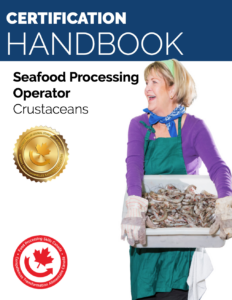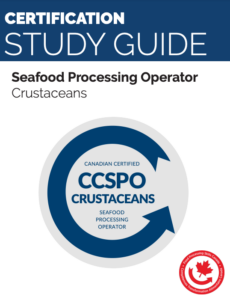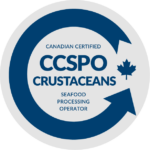
CANADIAN CERTIFIED
SEAFOOD PROCESSING OPERATOR
CRUSTACEANS
The Canadian Certified Seafood Processing Operator (CCSPO) Crustaceans certification is applicable to food processing professionals, which assesses the skills and knowledge against the National Occupational Standard for Fish & Seafood Primary Processor Professional, across three performance specialization streams:
- Shrimp
- Crab
- Lobster
The process for all three streams of certification shares a simple online exam that covers all three species, and a choice between three separate performance evaluations that a candidate can choose to partake in all of, or some of, depending on their performance specialization streams of interest.
INDUSTRY VALIDATION BY

LEVEL
ASSESSMENT
DELIVERY
ONLINE EXAM/ ASSESSMENT
PERFORMANCE ASSESSMENT
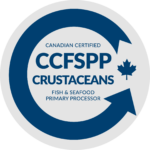
CANADIAN CERTIFIED
Seafood Processing Operator (CCSPO)
LEVEL 2
The Canadian Certified Seafood Processing Operator (CCSPO) Crustaceans certification is applicable to food processing professionals, which assesses the skills and knowledge against the National Occupational Standard for Fish & Seafood Primary Processor Professional, across three performance specialization streams:
- Shrimp
- Crab
- Lobster
The process for all three streams of certification shares a simple online exam that covers all three species, and a choice between three separate performance evaluations that a candidate can choose to partake in all of, or some of, depending on their performance specialization streams of interest.
INDUSTRY VALIDATION BY

LEVEL
ASSESSMENT
DELIVERY

Getting Started
A Standard of Excellence
Getting Started
A Standard of Excellence

CCSPO Video Review
Who Would Benefit from a CCSPO Certification?
Employees will:
- Increase their success in the Canadian Seafood Processing Industry
- Gain recognition with the new CCSPO: Crustaceans title in their name
- Become certified on:
- Processing lobster (tails, in-shell segments, meat), crab (meat, mince), shrimp.
- Preparation and transformation of in-process seafood products procedures such as blanching, brine-freezing, freezing, cooking, cooling, and retorting.
- Food safety, sanitation, pest control, and food packaging standards and procedures.
- Gain additional credentials to their experience for their Seafood Processing Operator knowledge
- Apply their knowledge within the facility and among their co-workers
- Instill safety standards to benefit millions of Canadians
- Increase their career opportunities for the future
- Demonstrate that they meet the national standard
Employers will:
- Increase the standards in their facility for food safety with your skills
- Benefit from your extended knowledge
- Learn from your leadership
- Demonstrate the industry’s high standards
Educators will:
- Attract students who will get a start on their career path
- Challenge the Knowledge Exam
- Obtain a Nationally recognized Canadian certification
- Educators that offer professional certifications can tap into new markets, boost enrolments, and become leaders in their field

Steps to achieve the CCSPO: Crustaceans Certification
Are you Eligible
Candidates must register for the CCSPO: Crustaceans certification by providing proof of employment of a minimum of 80 hours of practical work experience in a crustacean processing organization, in a position that is well within the specializations of either/ or Lobster, Crab, and Shrimp processing (e.g. blanching).
For cooking, candidates must have 160 hours of working experience in this specialization.
Candidates may also come from a variety of educational backgrounds, including, for example:
- On-the job training (Job shadowing or being partnered up with an experienced front-line worker is common)
- Apprenticeship programs
For Evaluators, a minimum of three years of experience in seafood processing, and a minimum of two years of supervisory experience.
Register and Payment
Once you have completed, submitted, and approved your application details to the registrar, you will be able to register for your Exam. After completing the registration form, you will be prompted to pay the exam fee.
Payment with Credit Card
Follow the given instructions and proceed to pay with your credit card.

Knowledge Exam (recommended step)
Certification for a certified Professional Seafood Processing Operator: Crustacean consists of two parts. One being the online proctored exam, which tests the knowledge of the candidates, and the other being the Performance Assessment which tests the demonstration of any seafood processing skills.
The 30-question exam for Certification is drawn from 16 Crustacean specific competencies which covers the 3 species, shrimp, crab and lobster, and 48 competencies from general food processing categories (see evaluated skills for more details).
All the candidates will be given a maximum of 1 hour to complete the online examination, and can access the exam at anywhere, anytime with the oversight of a online virtual proctor. Candidates must successfully complete the exam with a 75% passing score to complete this part of the certification.
Candidates who fail the first writing of the exam can take the exam a second time after one week. Exam rewrites must be completed within 3 months of the first attempt or candidates will need to re-register for certification. All exam registration and writings have a nominal fee to offset costs.
We recommend that this step be taken first, but the knowledge exam can be completed following the Performance Evaluation (Step 4) if seasonality/ viability concerns are in place; as long as both steps are completed within 1 year of certification registration.

Performance Evaluation
A successful performance evaluation which will be conducted by a trained in-house evaluator using a smartphone, tablet or digital camera (e.g. Go Pro) technology to record the candidates carrying out the tasks is the second part of the process.
For the CCSPO: Crustaceans certification there are three crustacean species with a total of 21 performance specialization:
- A candidate must be evaluated in at least one of these performance specializations to be certified and may choose to be evaluated in more or all of the 21 specializations.
- Candidates will be registered by their organization admin with their respective species.
- Candidates can request to add additional species to their performance examination.
- Please note not all tasks listed are required to be completed per species.
- Candidates and their evaluators will agree on what tasks will be completed during their performance exam.
The evaluator will also have to interact with the FoodCert digital interface to upload videos, complete checklists, enter observations, as well as auto-fill the performance summary score to demonstrate the candidate's skills in four task areas.
A work area is to be set up for the evaluation to be conducted. This area may be on the line or in a separate area set up for evaluation.
- A work area for the evaluation to be conducted. This may be on the line or in a separate area set up for evaluation.
- Relevant personnel, (e.g. Candidate's supervisor), has been notified about date and time of evaluation(s).
- PPE typically provided by the employer, e.g. disposable gloves, aprons
- Equipment/tools, e.g. knives to conduct any cuts
- PPE provided by the employer, e.g., disposable gloves, aprons
There is a maximum of 5 candidates to be assigned per evaluator, and the evaluator must meet the following requirements:
- Must have taken the CCSPO: Crustacean Knowledge Exam and Evaluator Training
- Working within the facility, may be direct supervisor or co-worker of candidates.
- Must have minimum of 3 years of experience in seafood processing.
- A minimum of 2 years supervisory experience Has access to the organization's Standard Operating Procedures (SOP), e.g., required PPE, etc.
- Can operate a device to take a video recording of the candidate's performance. This could include a GoPro camera with a tripod, an iPhone, or an Android device with a tripod.
- Access to a computer.
* PLEASE SEE THE INFORMATION BELOW FOR MORE INFORMATION ON THE SPECIALIZATION STREAMS FOR SHRIMP, LOBSTER, AND CRAB.
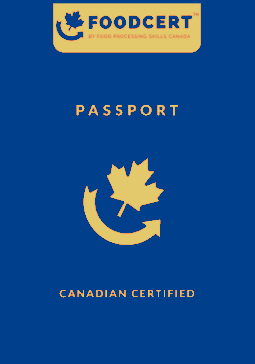
Certification of completion
Once passing both the knowledge exam and the performance evaluation, a certification completion package will be sent to you with the certification passport, certificate, and certification badge to acknowledge your skills and participation.

Knowledge Exam
The exam is based on a selection of the competency units found in the National Occupational Standard for Seafood Processing Operator. It is a virtually proctored exam consisting of 30 multiple choice questions; each question has four (4) possible choices, with only one (1) correct answer. All choices are designed to be realistic, qualified candidates will need to read the choices carefully in order to be successful.
Candidates have one hour (1 hour) to complete and submit the exam. The exam can be taken online at any time of the day and at any location of the candidate’s choice (i.e. home, closed office, library, etc.) with the oversight of a virtual proctor.
Virtually Proctored Exam
The CCSPO: Crustaceans Exams are taken in a “virtually proctored” environment. An online proctoring software monitors the examinee via a webcam as they complete the exam. Examinees are required to provide the proctoring software with two pieces of Government issued ID. Virtual proctors are available 24 hours a day, 7 days a week.

Performance Assessment
Candidates must achieve the passing score for each section of the performance evaluation for the applicable certification. Applicants will receive instructions from their In-House Evaluator and FPSC regarding the next steps for the Performance Assessment. Candidates will be registered by their organization admin with their respective species. Candidates can request to add additional species to their performance examination.
Performance Specialization:
A Performance specialization consists of specific, measurable tasks from the broader set of occupational standards for a Canadian Certified Fish and Seafood Primary Processor. The use of performance specializations recognizes the unique organizational structure of food processing facilities, where an individual is not producing an entire product but is completing specific tasks related to one or more aspects of creating that product; and/or an individual who may specialize in only one type of product for their entire career.
For the CCSPO: Crustaceans certification there are three crustacean species with a total of 21 performance specializations. A candidate must be evaluated in at least one of these performance specializations to be certified and may choose to be evaluated in more or all of the 21 specializations.
|
Crab Performance Specializations |
Shrimp Performance Specializations |
Lobster Performance Specializations |
| Brine Freeze | Cook and Peel | Blanch Lobster |
| Crab Butchering | Dry Packing | Brine Cooked Lobster Meat |
| Grading | Manually Inspect | Brine-Freeze Lobster |
| Crab Packing | Maturing | Brine Whole Lobster |
| Portion and Weigh Product | Wet Packing | Clean Raw Lobster Tails |
| Crab Shucking | Cook Lobster | |
| Cool Lobster | Cool Lobster | |
| Manually Grade Lobster | Manually Grade Lobster | |
| Packing | Packing | |
| Pick/Shuck Lobster | Pick/Shuck Lobster |
Please note not all tasks listed are required to be completed per species/ specialization stream. Candidates and their evaluators will agree on what tasks will be completed during their performance exam. Candidates must achieve the passing score for each of the sections of the performance evaluation as follows:
Shrimp:
| Performance Evaluation/ Assessment | Candidate Score | Required Score to Pass |
|---|---|---|
| Uses required PPE and Food safety protection equipment |
/2 | 2/2 |
| Cook and peel shrimp using automated equipment | /5 | 5/5 |
| Manually inspect shrimp | /2 | 2/2 |
| Prepare shrimp for primary processing | /9 | 9/9 |
| Fill and seal packages | /7 | 7/7 |
| Tray/Box Product | /6 | 6/6 |
| Palletize products | /5 | 5/5 |
Please note not all tasks listed are required to be completed per species. Candidates and their evaluators will agree on what tasks will be completed during their performance exam.
Lobster:
| Performance Evaluation/ Assessment | Candidate Score | Required Score to Pass |
|---|---|---|
| Uses required PPE and Food safety protection equipment |
/2 | 2/2 |
| Grade/inspect fish and seafood | /3 | 3/3 |
| Portion/Weigh product | /3 | 3/3 |
| Separate lobster into segments | /4 | 4/4 |
| Clean raw lobster tails | /6 | 6/6 |
| Brine-freeze crustaceans | /9 | 9/9 |
| Brine whole lobster | /6 | 6/6 |
| Brine cooked lobster meat | /3 | 3/3 |
| Crack lobster claws | /4 | 4/4 |
| Remove claw meat | /6 | 6/6 |
| Remove tail meat | /4 | 4/4 |
| Remove knuckle meat | /5 | 5/5 |
| Remove thumb meat | /5 | 5/5 |
| Fill and seal packages | /8 | 8/8 |
| Label products | /7 | 6/7 |
| Tray/Box Product | /6 | 6/6 |
| Cook lobster | /3 | 3/3 |
| Cool cooked lobster | /3 | 3/3 |
| Blanch lobster | /7 | 7/7 |
Please note not all tasks listed are required to be completed per species. Candidates and their evaluators will agree on what tasks will be completed during their performance exam.
Crab:
| Performance Evaluation/ Assessment | Candidate Score | Required Score to Pass |
|---|---|---|
| Uses required PPE and Food safety protection equipment |
/2 | 2/2 |
| Grade Crab | /5 | 5/5 |
| Butcher crab (live) | /4 | 4/4 |
| Prepare crab meat | /5 | 5/5 |
| Brine-freeze cooked crab | /3 | 3/3 |
| Portion/Weigh crab | /4 | 4/4 |
| Label products | /6 | 6/6 |
| Fill and seal packages | /5 | 5/5 |
| Tray/Box Product | /8 | 8/8 |
| Palletize products | /7 | 7/7 |
Please note not all tasks listed are required to be completed per species. Candidates and their evaluators will agree on what tasks will be completed during their performance exam.
Resources
Jobs that use CCSPO: Crustaceans
Seafood Front-line Processor
Shellfish Shucker
Shellfish Processor
Seafood Preparer
Fish Plant Worker
Exam Details
Exam Description
CCSPO:
The CCSPO: Crustaceans Exam is taken in a “virtually proctored”
environment. An online proctoring software monitors the examinee via
a webcam as they complete the exam.
Number of Questions
This exam consists of 30 questions
Passing Score
75%
Type of Questions
Multiple choice
Length of Test
1 hour
Recommended Experience
- a minimum of 80 hours of practical work experience in a crustacean processing organization, in a position that is well within the specializations of either/ or Lobster, Crab, and Shrimp processing (e.g. blanching).
- For cooking, candidates must have 160 hours of working experience in this specialization.
Languages
English, French
Renewal
No certification renewal required.
Price
Frequently Asked Questions (FAQs)
No, you do not need to sign-up anywhere before purchasing an exam. An account will be created under your registered email address, AFTER your application gets approved by the FoodCert™ team.
You can refer to our prices here: https://foodcert.ca/store/. Our registration application will also show a price list, specific to the certification you are applying for. Please note, prices may be subject to change.
We accept all major payment methods:
- Cheques
- Credit Cards
- Visa
- Master Card
- Amex
- E-transfers
- Cash
You can find many helpful tools (specific to this exam) by clicking the resources link in the menu. We offer resources such as: Practice Exam, Study Guide, Handbook, and more.
Though the materials may differ based on the specific exam, we recommend having a high-speed Wi-Fi, working laptop, webcam, and pieces of government ID (for verification purposes).
All FoodCert™ notifications will be sent to the email address you use when filling out the exam application. This will be your official registered email address in our FoodCert™ database.
Be sure to check in your Spam folder! If you are still having issues viewing your notifications, please let us know at foodcert@fpsc-ctac.com.
We are available during working hours (Mon-Fri, 9 am – 5 pm) on foodcert@fpsc-ctac.com. You can also phone us at 613-237-7988, Toll-Free 1-877-963-7472.
Do not worry! After successfully completing the last component of the certification, you should receive an official email from the FoodCert™ team asking you to confirm your mailing address. Be sure to include the one which is most accessible for you!
As we use Canada Post as our choice of delivery company, you can expect your package to reach you anytime between 2-5 business days (if local). Please note, we do not take responsibility for any unexpected delays due to any unavoidable external conditions (e.g., weather). Rest assured, we will do our best to make sure that your certification package reaches you safely and promptly!
At this time only Canadian citizens are able to participate for our certifications. For further information or inquiries please contact us directly foodcert@fpsc-ctac.com
If you have a disability or other special needs that could interfere with your test
performance, you may be entitled to receive special accommodations. If this is
applicable to your situation, fill out and submit the Accommodation Request Form to
the Registrar’s Office, as soon as possible. At the latest, the form must be submitted a
minimum of 5 business days before your scheduled exam.
Special accommodation requests will be assessed on a case-by-case basis.
For the purposes of this exam, all forms of ID must include a photo and your full name.
In Canada, the following are acceptable forms of Government Issued ID:
- Registered driver’s license
- Passport
- Nexus Card/ Pass
- Health Card – must have picture to be valid
- Citizenship, Permanent Resident, Immigration/ Refugee Card – must have picture to be valid
- Certificate of Indian Status (laminated card issued by Indian & Northern Affairs Canada)
- Age of majority card
For questions relating to acceptable forms of ID, please contact foodcert@fpsc-ctac.com; all discrepancies will be handled on a case-by –case basis.


